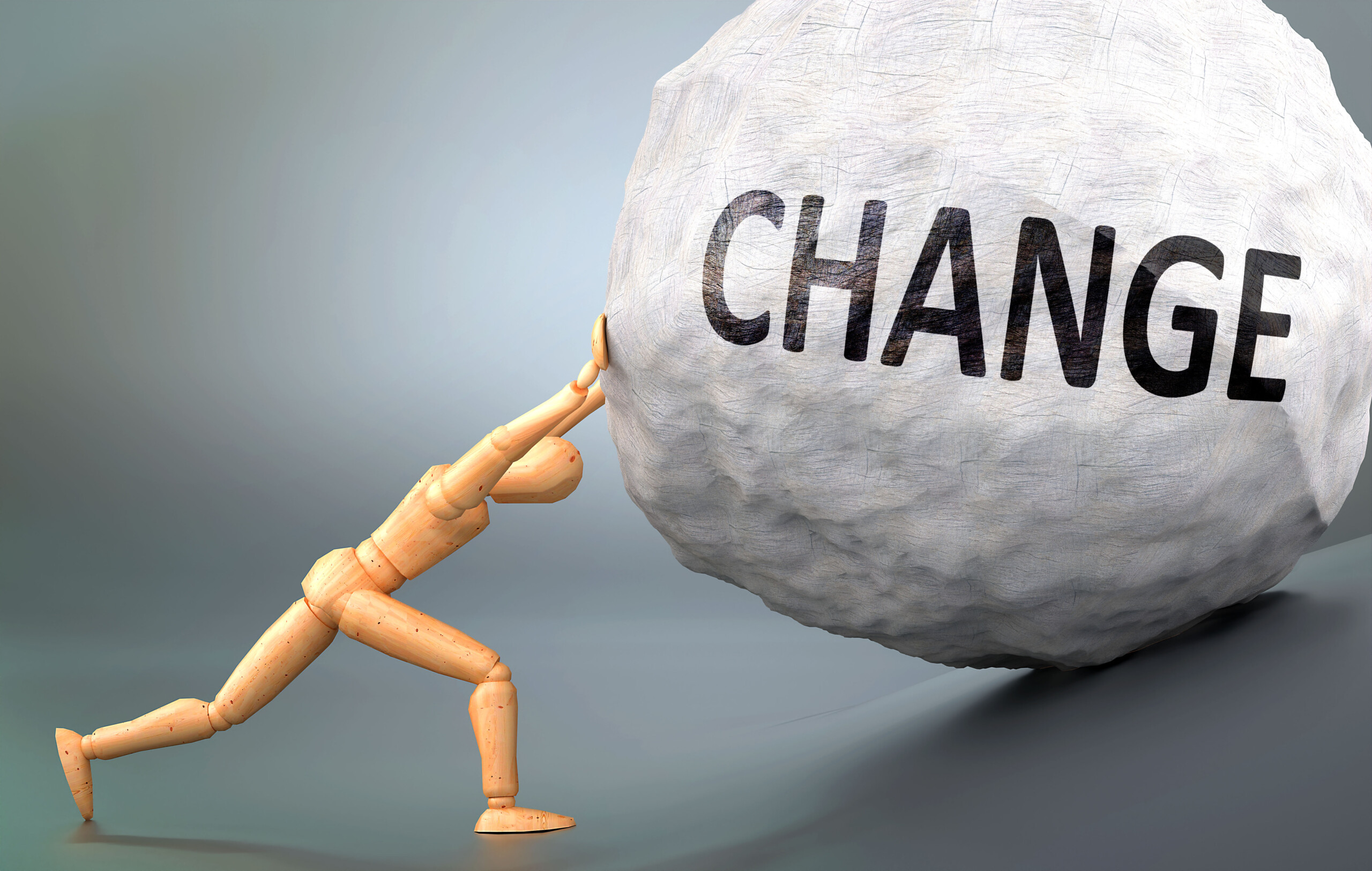“Every company needs transformational leaders—those who spearhead changes that elevate profitability, expand market share, and change the rules of the game in their industry. But few executives understand the unique strengths needed to become such a leader.” – David Rooke and William R. Torbert
Part Six: Now What?
When we look at the correlation between leadership effectiveness and vertical development, it’s easy to see why growth in consciousness matters. But why does vertical development matter to change management practitioners? The answer is simple: In an era when change is exponential, leadership and change management are inseparable.
Development expert Patrick Forth likens the current landscape to a confrontation between an irresistible force and an immovable object. The irresistible force is the technology disruption that leaves no business unaffected.
The immovable object is the inability of large companies to keep pace with the rate of change. This confrontation “will have a life or death impact on the world’s largest and best companies which drive our economies,” says Forth. Vertical development determines whether organizations will adapt or be forced to drop out of the race.
Self-Centric and Group-Centric leaders are significantly less effective with complexity and change management than Self-Determining leaders, and only Postconventional leaders have the consistent capacity to transform. Below is a summary of how each stage generally experiences change.
|
Stage |
Approach to Change |
| Self-Centric | I like change when it gets me what I want. |
| Group-Centric | I dislike change unless sponsored by the group leader. |
| Skill-Centric | I accept change when it comes from an expert source or I think it is the right thing to do. |
| Self-Determining | I’m interested in change to the extent it serves the outcomes I want to achieve. |
| Self-Questioning | I reject much of “the way things are done here,” so let’s change it. |
| Self-Actualizing | I’m interested in sustainable, transformational change. |
| Construct-Aware | I think beyond my own lifetime using a global perspective. |
Personal Transformation and Leadership Development
David Rooke and William R. Torbert spent 25 years studying the leadership styles of executives from well-known companies including Volvo, Hewlett-Packard, and Deutsche Bank through a vertical development lens. They state that, “leaders who do undertake a voyage of personal understanding and development can transform not only their own capabilities but also those of their companies.” Leaders in the final one percent of effectiveness (Construct-Aware) have “an extraordinary capacity to deal simultaneously with many situations at multiple levels,” state Rooke and Torbert.
Assessing Vertical Development Stage
By now you may be wondering how to put the power of the vertical development framework to work for you and your organization. Begin by determining the stages where you or your team members make meaning, and which one is the center of gravity.
The Maturity Assessment Profile, or MAP, is regarded as the most reliable and cost-effective measure of adult development. To understand a person’s stage in the context of this larger journey it’s important to be aware of what might come next in order to customize development interventions for vertical growth.
Another option is the Leadership Circle Profile 360. The LCP 360 integrates a foundational understanding of vertical development—connecting patterns of action (skills and competencies) with habits of thought (vertical development) in an easy-to-understand format.
Three Ingredients for Vertical Development
Once someone understands their place in the vertical development journey, the next question is how to grow vertically. As you may have guessed, vertical development can’t be simplified into a lockstep program the way skill instruction can. However, Nick Petrie with CCL lays out three ingredients leaders must experience in order to grow vertically.
- Heat Experiences
A heat experience is a complex situation that disrupts a habitual way of thinking. For many leaders, the first heat experience arrives with the first promotion to a role where they’re leading people. Suddenly, what they know about how to get the work done isn’t sufficient to select, retain, and manage their team. They have to learn to get things done through others—a radical shift from their previous experience.
Heat experiences are defined by five criteria: 1) first-time experience, 2) results matter, 3) chance of success or failure, 4) people are watching, and 5) it is extremely uncomfortable. A potential pitfall around heat experiences is mistaking a lot of work for a lot of heat. A successful experience will cause you to think, feel, and act in entirely new ways.
- Colliding Perspectives
Exposure to people with different worldviews, opinions, and background creates a rich environment for vertical development.
From a leadership and change management standpoint, you can collide perspectives by surrounding yourself with people who think in radically different ways, nurturing connections with people outside your network, and seeking the perspectives of others around challenges you’re facing.
- Reflecting and Integrating
Once the leader develops vertically from heat experiences and colliding perspectives, she then uses a process or coach to help her make sense from elevated stages of development. Think of Professor Dumbledore guiding Harry Potter. The best vertical development occurs under the guidance of an ambassador to higher levels of consciousness.
Next Steps
There is tremendous opportunity to reconceive how we think about developing people to lead change. The role of change sponsor has traditionally been defined through competencies and behaviors using a horizontal development lens. Exponential change is our new normal, and vertical development presents an opportunity to cultivate leaders who can help organizations thrive in a complex world.
I hope you’ve enjoyed this series, and I invite you to continue this conversation by or contacting me at [email protected] to learn more about what I do.
Extension Questions:
- What is your biggest takeaway from this article series?
- What next step can you take to integrate vertical development into your current leadership development and change management efforts?
Resources:
- Berger, Jennifer Garvey. (2019). “Unlocking Leadership Mindtraps: How to Thrive in Complexity.” Stanford University Press.
- Berger, Jennifer Garvey and Johnston, Keith. (2015). “Simple Habits for Complex Times: Powerful Practices for Leaders.” Stanford University Press.
- Berger, Jennifer Garve. (2012). “Changing on the Job: Developing Leaders for a Complex World.” Stanford University Press.
- Bronzert, Jessica (2019). “Vertical Development: The Most Important Leadership Development Idea You Don’t Know About.” North Carolina SHRM Conference, September 2019. https://www.youtube.com/watch?v=jbElj6WkOy0
- Forth, Patrick (2014). “How can companies continue to thrive in times of change?” TED Institute.
https://www.ted.com/talks/patrick_forth_how_can_companies_continue_to_thrive_in_times_of_change - Petrie, Nicholas (2019). “How to Introduce Vertical Development to Your Organization.” Nicholas Petrie, LLC.
https://14226776-c20f-46a2-bcd6-85cefe57153f.filesusr.com/ugd/a8b141_d0296bfac41f4dbda747471106c3a52a.pdf - Rooke, David, and Torbert, William R. (2005). “Seven Transformations of Leadership.” Harvard Business Review.
https://hbr.org/2005/04/seven-transformations-of-leadership - Strang, Sarah E. and Kuhnert, Karl W. (2009). “Personality and Leadership Developmental Levels as predictors of leader performance.” The Leadership Quarterly 20:421-433. http://www.verticaldevelopment.com/wp-content/uploads/2018/05/4.-Strang-and-Kuhnert-Leader-Levels-as-Predictors-of-Performance.pdf

























